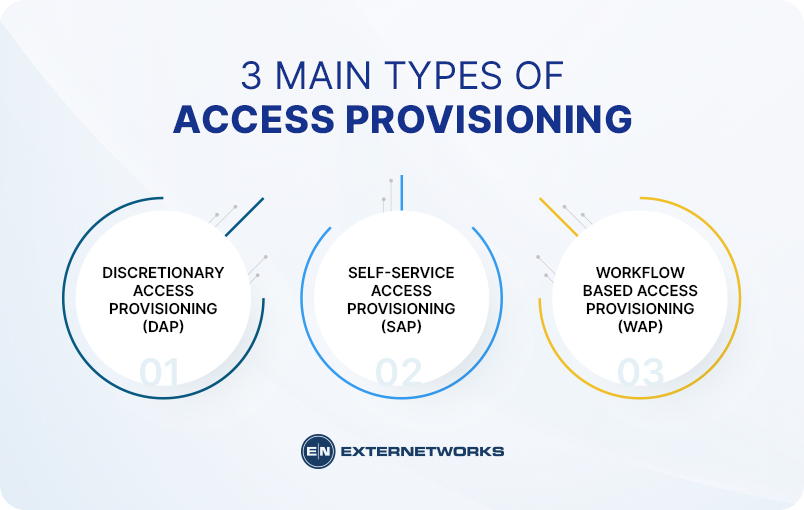Access provisioning refers to a set of activities performed during the initial setup of a computer system. These activities include creating user accounts, assigning passwords, authorizing email addresses, and granting permissions to access various types of data.
Keep your networks in check! Our monitoring services offer proactive solutions for a seamless digital experience. Elevate your business now!
Request a Call BackThree main types of access provisioning can be used in organizations today:

Let us know the unique benefits and drawbacks of each type:
This type of access provisioning is typically used for small businesses and departments within larger companies.
DAP allows employees to create their own user accounts and assign their own passwords.
It also gives them control over their email address and what they can do with it.
However, this type of access provisioning does not provide any security measures against unauthorized use of information.
Employees must remember all of their usernames and passwords, which makes it easy for someone else to gain access to sensitive data if the employee forgets his/her password.
Self-service access provisioning provides a way for employees to manage their own user accounts and passwords.
The benefit of using this type of access provision is that it reduces the amount of time required to change passwords and other access settings. For example, instead of having to wait for IT staff to manually add new users to the company’s Active Directory environment, employees can simply log into the network themselves and add their own accounts.
The drawback to self-service access provision is that it requires employees to know how to perform these tasks.
If they don’t know how to complete one of the steps, they may inadvertently make mistakes when setting up their accounts.
Workflow-based access provisioning is similar to self-service access, but it uses workflows to automate the process.
Workflows allow you to define rules for different actions that need to happen as part of the provisioning process. You can then schedule those actions to occur at specific times.
For example, let’s say your organization needs to grant access to several hundred employees. Instead of assigning each person a username and password, you could set up a workflow to automatically generate a username and password for each user.
Then, you would only need to approve the generated credentials once.
In addition to providing a secure environment for your organization’s employees, access provisioning helps you manage costs and ensure compliance with regulations such as HIPAA.
Providing access to information and applications is a key component in any IT infrastructure that supports an organization’s business processes and information technology systems.
For example, a sales manager might have access to all sales-related applications and data.
Enterprises without effective user account provision management tools in place may be wasting valuable work time fixing permission problems.
Imagine the scenario where a whole team is working on a big project but finds out at the last minute that they don’t have access to important applications and files they need to complete the project.
Without a tool to help, setting up a new access group for each user and assigning them the appropriate permissions could be a lengthy process.
Meanwhile, the team has been unable to continue working, other issues are piling on top of one another for the admin, and the productivity of the company is reduced.
If you want users to be able to access multiple applications with one set of login credentials, you can set up a single sign-on. With a well-formulated User Provisioning Plan, clear protocols, and efficient and user-friendly Provisioning Software, these hiccups will be avoided.
The next important thing to consider is security. Security issues can come from both outsides (the Internet) and inside the organization (employees).
If users have too many permissions, this could leave your entire system vulnerable to attacks. If someone gained unauthorized access to your system, they could only do so by compromising just one account with a lot of privileges and access, such as a superuser account. Intruders are always looking for weak spots in an organization, and overly permissive user permissions can be a huge weak spot.
It’s also important for companies to protect against the unlikely event that an employee is maliciously trying to gain access to sensitive information or important files.
Access provisioning processes for user permissions can help prevent users from accessing sensitive documents or confidential information.
Finally, the issue related to auditing and compliance also relates to the problem of security when creating new user accounts. If your enterprise deals in sensitive information, such as personal financial or health data, then there are compliance measures that need to be followed, including having appropriate access to the data.
These kinds of rules apply to financial information, private business information, and confidential governmental data as well. If your business deals with any kind of sensitive data, your customer provisioning processes and your access management policies are critical to keeping your organization safe.
So whether you choose to deploy an access provisioning solution in your Organization or not, it is important to realize that there are ways to simplify network access management and related processes. Our experts will provide you with enough support to help you make a more informed decision.
